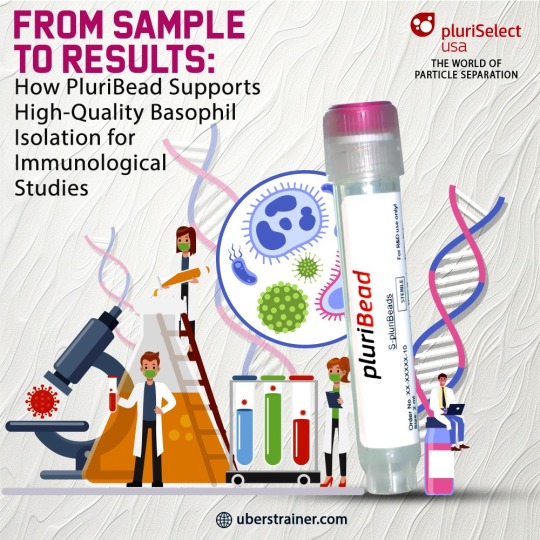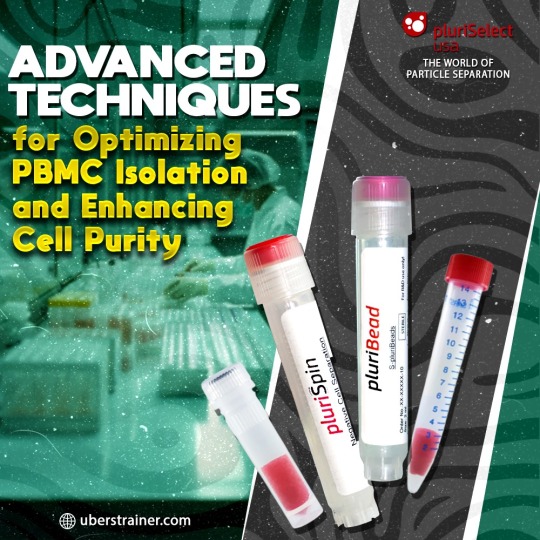Text

From Sample to Results: How PluriBead Supports High-Quality Basophil Isolation for Immunological Studies
PluriBead provides a streamlined, non-magnetic solution for efficient basophil isolation, simplifying the process and enhancing sample quality through advanced antibody cell separation techniques.
When it comes to high-quality cell isolation, the right technology can make all the difference. For researchers focused on basophil isolation and related immunological studies, PluriBead offers a cutting-edge solution that simplifies and enhances the process. This blog will explore how PluriBead supports efficient basophil isolation using advanced antibody cell separation techniques, delivering reliable results for your research needs.
What Makes PluriBead Stand Out?
PluriBead is a unique cell separation technology that distinguishes itself by working without magnetic components. This non-magnetic approach is designed to streamline the process, making it simpler and more efficient. Unlike traditional methods that require complex procedures or additional equipment, PluriBead offers a straightforward solution: sieve the PluriBeads with bound target cells through a lab cell strainer. The beads with your target cells remain on top, while unwanted cells pass through. After a simple detachment step, your target cells are ready for further analysis.
Key Features of PluriBead for Basophil Isolation
No Sample Preparation Required: One of the main advantages of PluriBead is its simplicity. You can use samples ranging from 200 µl to 45 ml without the need for gradient centrifugation, erythrolysis, or other pre-treatments. This saves time and reduces the complexity of your workflow.
Versatile Sample Materials: PluriBead can handle a wide range of sample types, including whole blood, buffy coat, PBMCs, and various tissues like brain homogenates, spleen, and liver. This versatility ensures that you can adapt the technology to your specific research needs.
High Range of Species: Whether you're working with human, mouse, rat, bovine, canine, or sheep samples, PluriBead accommodates various species. This broad application range is beneficial for comparative studies and cross-species research.
Fast and Gentle Isolation: PluriBead supports fast isolation starting from just 5 minutes. Its gentle approach ensures a high yield of viable cells, minimizing sample requirements and preserving the integrity of your basophils.
Universal Beads for Any Antibody: The PluriBead technology is compatible with any external antibody, providing flexibility in selecting the most suitable markers for your research.
Simultaneous and Sequential Cell Isolation: With PluriBead Cascade straining, you can separate two different cell types simultaneously from a single sample. Additionally, sequential isolation allows you to target up to six different cells from one sample, enhancing your research efficiency.
How PluriBead Enhances Basophil Isolation
Basophils play a critical role in immune responses and are often challenging to isolate due to their low abundance and delicate nature. PluriBead’s non-magnetic cell separation technology is particularly advantageous for isolating these cells. By leveraging PluriBead, researchers can achieve high-purity basophil samples without the complications associated with magnetic bead-based methods.
1. Simple and Effective Workflow: The PluriBead process is streamlined. Start by labeling your sample with the appropriate antibody. Next, incubate the sample to allow binding of the target basophils to the beads. During isolation, the beads with the bound basophils are retained, while the non-target cells are removed. Washing and detaching the basophils from the beads completes the process, providing a ready-to-use sample for downstream applications.
2. Enhanced Sensitivity and Specificity: By avoiding the need for complex pre-treatments and using a non-magnetic approach, PluriBead minimizes potential sources of error and maximizes sensitivity. This ensures that you obtain high-quality basophil isolates, which is crucial for accurate immunological studies.
3. Flexible Applications: PluriBead’s ability to handle various sample types and its compatibility with different antibodies make it a versatile tool for a wide range of applications. Whether you are studying basophils in blood samples or tissue homogenates, PluriBead adapts to your needs.
Conclusion
For researchers and labs focused on basophil isolation and immunological studies, PluriBead offers a robust and efficient solution. Its non-magnetic cell separation technology simplifies the workflow, providing high-quality basophil samples without the need for extensive sample preparation. By incorporating PluriBead into your research, you can leverage advanced antibody cell separation techniques and cell separation technology to enhance your studies and achieve reliable results.
Explore how PluriBead can transform your cell isolation processes and support your research endeavors today.
#antibody cell separation#cell separation technology#particle separation techniques#particle filtration#40 um cell strainer#cell enrichment techniques#medical#uberstrainer
0 notes
Text

Achieve Precision Filtration: Shop Cascade Strainers at Uberstrainer
Achieve precise particle separation with strainer cascade from Uberstrainer. Explore our range of high-quality filtration solutions.
visit us :- https://uberstrainer.com/
#antibody cell separation#uberstrainer#cell separation technology#particle filtration#particle separation techniques#40 um cell strainer#cell enrichment techniques
0 notes
Text

Maximizing Efficiency with ÜberStrainer: Tips for Better Cell Separation and Filtration
In laboratory research, optimizing cell separation and filtration is key to achieving precise and high-quality results. When it comes to selecting the best lab cell strainers, ÜberStrainer stands out as a top choice. Designed to enhance your workflow and deliver reliable outcomes, ÜberStrainer offers a range of features that make it an essential tool for researchers and labs focused on precision and efficiency.
VCISIT US :- https://uberstrainer.com/
#uberstrainer#antibody cell separation#cell separation technology#particle filtration#particle separation techniques#40 um cell strainer#cell enrichment techniques
0 notes
Text

From Whole Blood to Purified Cells: Mastering Cell Separation with PluriMate and TwinSpin
PluriMate and TwinSpin streamline the cell separation process by utilizing the density gradient centrifugation principle to efficiently isolate high-quality cells for research.
visit us :- https://uberstrainer.com/
#antibody cell separation#cell separation technology#particle separation techniques#particle filtration#40 um cell strainer#cell enrichment techniques#uberstrainer#cellsepration
0 notes
Text

Precision Filtration: Shop In-Line Strainers at Uberstrainer
Achieve precise filtration with our in-line strainers. Explore our range of solutions for effective particle separation.
#antibody cell separation#cell separation technology#particle separation techniques#particle filtration#40 um cell strainer#cell enrichment techniques#uberstrainer
0 notes
Text

Advanced Techniques for Optimizing PBMC Isolation and Enhancing Cell Purity
Due to their significant role in immune response, PBMCs are widely used in research and clinical applications. Isolating PBMCs efficiently and effectively is crucial, and advanced techniques like density gradient centrifugation principle play a pivotal role in this process.
#uberstrainer#antibody cell separation#particle separation techniques#particle filtration#cell separation technology#40 um cell strainer#cell enrichment techniques
0 notes
Text

Optimizing Effector T Cell Separation: Advanced Techniques and Tools for Enhanced Research Efficiency
The article explores the importance of effector T cell separation, detailing various T cell types and discusses advanced cell separation products like pluriSpin and pluriBead to enhance research efficiency in labs.
Effector T cells are critical components of the immune system, actively responding to various stimuli such as co-stimulation. These cells include several types of T cells, such as CD4+, CD8+, and regulatory T (Treg) cells, each playing a distinct role in maintaining immune homeostasis and combating infections and diseases. For researchers and laboratories, the ability to isolate these cells efficiently and effectively is vital for studying immune responses, developing therapies, and conducting clinical research.
To achieve optimal Antibody Cell Separation, advanced cell separation technology is essential. This article delves into the specifics of effector T cell types, the importance of isolating these cells, and how innovative products like pluriSpin and pluriBead enhance the efficiency and effectiveness of this process.
Types of Effector T Cells and Their Roles
Effector T cells encompass a variety of T cell types, each with a specific function within the immune response. Understanding these roles is crucial for researchers who need to isolate these cells for various applications.
1. Regulatory T Cells (Treg Cells)
Regulatory T cells, or Treg cells, are essential for maintaining immune tolerance and preventing autoimmunity. Their primary role is to suppress the immune response after it has successfully neutralized a pathogen, ensuring that the immune system does not overreact. Treg cells also play a crucial role in suppressing auto-reactive T cells that may have escaped the thymus during negative selection. Efficient isolation of Treg cells is crucial for studying autoimmune diseases, transplantation tolerance, and immunotherapy.
2. Helper T Cells (Th Cells)
Helper T cells, or Th cells, assist other leukocytes in immunological processes. They are pivotal in the maturation of B cells into plasma cells and memory B cells, which are crucial for the body's long-term immune response. Isolating pure Th cells allows researchers to better understand their role in various immunological processes and in developing vaccines and immune therapies.
3. Cytotoxic T Cells (Tc Cells)
Cytotoxic T cells, also known as killer T cells, are responsible for destroying virus-infected cells and tumor cells. They are also involved in transplant rejection. The ability to isolate these cells with high purity is vital for research focused on cancer immunotherapy, viral infections, and transplant immunology.
The Importance of Advanced Cell Separation Technology
Isolating effector T cells from complex sample materials like whole blood, buffy coat, and cord blood requires precision and efficiency. Traditional methods, while foundational, often fall short in delivering the purity and yield required for advanced research. This is where advanced cell separation technology comes into play, offering researchers the tools they need to obtain high-quality, viable cells with minimal manipulation.
The following sections will explore how pluriSpin and pluriBead technologies facilitate the efficient isolation of effector T cells, highlighting their benefits and applications.
pluriSpin: Negative Cell Isolation for Untouched Cells
The pluriSpin system is designed for the negative isolation of untouched and highly purified cells directly from whole blood, buffy coat, or cord blood. Negative isolation is a technique where unwanted cells are labeled and removed, leaving the target cells untouched and ready for downstream applications.
pluriBead: A Novel Approach to Cell Isolation
pluriBead technology offers a unique approach to cell separation that does not rely on magnetic components. Instead, it uses a physical separation method that is simple, efficient, and effective for a wide range of applications. pluriBead is available in specific formulations for the positive isolation of CD4+ and CD8+ T cells from both human and murine samples. This flexibility allows researchers to tailor their cell isolation procedures to their specific experimental needs.
Conclusion: Enhancing Research with Advanced Cell Separation Technology
For researchers and laboratories, the ability to efficiently and effectively isolate effector T cells is crucial for advancing our understanding of immune responses, developing new therapies, and conducting cutting-edge research. Advanced cell separation technology, such as pluriSpin and pluriBead, offers innovative solutions that enhance the purity, viability, and functionality of isolated cells.
These technologies are designed to meet the needs of modern research, providing tools that simplify the cell isolation process while delivering high-quality results. By incorporating pluriSpin and pluriBead into their workflows, researchers can focus on their experiments with confidence, knowing that they are working with the best cell separation techniques available. Whether you're studying the role of regulatory T cells in autoimmune diseases, investigating helper T cell function in vaccine development, or exploring cytotoxic T cells in cancer immunotherapy, these advanced cell separation products will support your research goals by providing reliable, efficient, and effective cell isolation solutions.
#uberstrainer#antibody cell separation#particle separation techniques#cell separation technology#particle filtration#40 um cell strainer#cell enrichment techniques
0 notes
Text

Precision Particle Filtration Solutions | Uberstraine
Efficiently filter particles filtration with our advanced solutions. Enhance accuracy and reliability in your research experiments.
0 notes
Text

Streamline Your Cell Separation with pluriMate: The Ultimate Tool for Efficient Antibody Cell Separation
This blog explores the pluriMate's capabilities for antibody cell separation, highlighting its efficient cell separation, ease of use, and versatility in laboratory settings.
Antibody cell separation is a critical technique in various scientific and medical disciplines, enabling researchers to isolate specific cell populations for further analysis. While traditional methods like density gradient centrifugation have been employed for years, they often involve complex procedures and increase the risk of contamination. The need for efficient and reliable cell separation solutions has led to the development of innovative technologies, such as the pluriMate system.
How pluriMate Enhances Antibody Cell Separation
Antibody cell separation involves isolating specific cell types from a mixture, which is critical in various research and clinical applications. The pluriMate redefines this process by leveraging its unique design to streamline the separation of leukocytes and PBMCs. Traditional methods often require meticulous layering of sample material over a density gradient medium, a task that can be both time-consuming and prone to errors. However, with pluriMate, this cumbersome step is eliminated.
The device's porous barrier, made from high-grade polyurethane, prevents the direct mixing of sample material with the separation medium. This allows for a straightforward pouring of anticoagulated blood or bone marrow directly into the pluriMate tube. During centrifugation, the device efficiently separates leucocytes, lymphocytes, and PBMCs based on their density, utilizing various density gradients like Leuko Spin, Lympho Spin, and PLT Spin. The result is a clean separation with the enriched cell fraction residing in an interphase above the separation medium, safeguarded from contamination during harvest.
Key Features and Benefits
Simple Filling Process
One of the standout features of pluriMate® is its simple filling process. Unlike conventional methods that require careful layering of blood over the separation medium, pluriMate eliminates this step. This design innovation not only reduces the risk of contamination but also streamlines the preparation process, saving valuable time in the laboratory.
Reduced Contamination Risk
With pluriMate, the risk of contamination is significantly lowered. The integrated porous sponge acts as a barrier that prevents sample material from mixing with the separation medium. This ensures that the final cell fraction remains pure and free from unwanted cell types or debris, which is crucial for accurate and reliable results in antibody cell separation.
Versatility with Cell Separation Techniques
The pluriMate is compatible with various cell separation techniques and can be used in conjunction with products like pluriSpin. By simply adding the pluriSpin solution to the sample, incubating, and spinning down, researchers can achieve efficient negative cell separation. This versatility makes pluriMate a valuable asset for a wide range of applications, from basic research to advanced clinical studies.
Pre-filled and Unfilled Options
pluriMate offers both pre-filled and unfilled options. The pre-filled version minimizes preparation effort and ensures consistency in the density gradient medium. For those who prefer to customize their gradients or work with specific protocols, the unfilled option provides flexibility while still benefiting from the device's advanced separation capabilities.
Applications of pluriMate in Research
The pluriMate is designed to meet the demands of diverse research and industrial applications. In research settings, it facilitates the rapid and accurate separation of target cells, essential for studies involving cell function, genetic analysis, and more. In clinical laboratories, it supports efficient processing of blood samples for diagnostic purposes.
How to Use pluriMate for Optimal Results
To achieve optimal results with pluriMate®, follow these steps:
Prepare the Sample: Anticoagulated blood or bone marrow should be collected and ready for processing.
Fill the Tube: Pour the sample directly into the pluriMate tube, taking advantage of its simple filling process.
Centrifuge: Perform centrifugation based on the selected density gradient protocol (e.g., Leuko Spin).
Harvest Cells: After centrifugation, carefully collect the enriched cell fraction from the interphase, protected from contamination by the porous sponge.
Conclusion
The pluriMate is a powerful tool in the realm of antibody cell separation and cell enrichment techniques. Its innovative design simplifies the cell separation process, reduces contamination risk, and offers versatility across various applications. By integrating pluriMate into your laboratory workflows, you can achieve more efficient and reliable results, making it an indispensable asset for researchers and businesses dedicated to advancing cellular studies.
#uberstrainer#antibody cell separation#cell separation technology#particle filtration#cell enrichment techniques#syringe strainer
0 notes
Text

Precision in Every Drop: Mini-Strainer for Lab Efficiency
Achieve precise particle filtration with Mini-Strainer 30 µm mesh. Optimized solutions for small sample volumes and various tube fittings.
VISIT US :- https://uberstrainer.com/
0 notes
Text

Explore Antibody Cell Separation Products | Uberstrainer
Enhance your cell isolation techniques with Uberstrainer's range of antibody-based solutions. Achieve reproducible and efficient cell separations for your research needs.
visit us :- https://uberstrainer.com/
0 notes
Text

Mini Strainer: Enhancing Laboratory Research with Precise Filtration Solutions
Discover the versatility and precision of Mini Strainers in laboratory research, essential for filtering small sample volumes with specific pore sizes, optimizing experimental processes from sample preparation to flow cytometry and cell labeling applications.
Cell strainers are indispensable tools in laboratory research, enabling precise filtration of samples for various applications. Among them, the Mini Strainer stands out for its capability to handle small sample volumes with unparalleled efficiency. This article explores the features, applications, and benefits of Mini Strainers, emphasizing their critical role in advancing research methodologies and ensuring reliable experimental outcomes.
Understanding Mini Strainers
Mini Strainers are meticulously designed lab cell strainers crafted to accommodate small sample volumes, ranging up to 700 µl. They are compatible with a wide array of reaction tubes, including sizes from 15 ml to 1.5 ml, and can seamlessly fit into 24 or 48 well plates. The cell strainers offer flexibility in pore sizes, ranging from 5 µm to 200 µm, catering to diverse filtration needs depending on the specific application.
Features of Mini Strainers
Wide Range of Pore Sizes: Mini Strainers are available in various pore sizes, including 5 µm, 10 µm, 20 µm, 40 µm, 70 µm, 100 µm, and 200 µm. This versatility allows researchers to select the most suitable mesh size for precise particle removal and sample preparation.
Optimized for Small Sample Volumes: Designed specifically for small-scale applications, Mini Strainers ensure optimal performance and efficiency when working with limited sample volumes. They are ideal for processing minute quantities without compromising on filtration quality.
1 ml Reservoir: Each Mini Strainer includes a 1 ml reservoir, facilitating easy handling and collection of filtered samples. This reservoir enhances workflow efficiency by minimizing the need for additional transfer steps during sample processing.
Sterile and Ready-to-Use: Mini Strainers come pre-sterilized, ensuring aseptic conditions for laboratory procedures. Their ready-to-use nature simplifies setup and reduces the risk of contamination, crucial for maintaining the integrity of experimental results.
Replaceable Components: Featuring a replaceable strainer cap and pre-separation filters, Mini Strainers offer cost-effective usability. Researchers can easily swap out components as needed, extending the lifespan of the device and optimizing filtration performance.
Applications of Mini Strainers
Mini Strainers find extensive applications across various laboratory research domains:
Sample Preparation for Flow Cytometry: The 40 µm and 70 µm pore sizes are particularly effective for preparing samples for fluorescence-activated cell sorting (FACS) analysis. These strainers remove cell aggregates and debris, ensuring clean samples for accurate cytometric analysis.
Cell Suspension Preparation: Mini Strainers facilitate the preparation of uniform cell suspensions by removing large particles and cell clusters from biological samples. This step is crucial for downstream applications such as cell culture and molecular analysis.
Blood Sample Processing: In hematology and clinical research, Mini Strainers are used to remove coagulum and large particles from blood samples. This improves the quality of blood components isolated for further diagnostic or research purposes.
Magnetic or Fluorescent Cell Labeling: Before labeling cells for magnetic separation or fluorescent analysis, Mini Strainers ensure that samples are free from unwanted debris and contaminants. This enhances the specificity and accuracy of labeling procedures.
Advantages of Mini Strainers in Laboratory Research
Enhanced Precision: The ability to choose from multiple pore sizes allows researchers to achieve precise filtration tailored to their experimental requirements. This precision is crucial for obtaining reliable and reproducible results.
Workflow Efficiency: Mini Strainers streamline laboratory workflows by simplifying sample preparation processes. Their compact size and compatibility with various tube formats minimize handling steps, saving time and reducing the risk of sample loss or contamination.
Cost-Effective Solution: By replacing only the necessary components like strainer caps and filters, Mini Strainers offer a cost-effective filtration solution. Researchers can optimize resources without compromising on filtration quality.
Versatility and Compatibility: Whether used in academic research, pharmaceutical development, or biotechnology applications, Mini Strainers adapt to diverse laboratory environments. Their compatibility with standard laboratory equipment ensures seamless integration into existing workflows.
Conclusion
Mini Strainers is a cell strainer used in laboratory research, dedicated to enhancing sample preparation and filtration efficiency for small sample volumes. With their customizable pore sizes, sterile design, and broad applicability, Mini Strainers empower researchers to conduct precise experiments across various scientific disciplines. By investing in Mini Strainers, laboratories can achieve consistent and high-quality results, advancing discoveries in biomedicine, molecular biology, and beyond.
#uberstrainer#Cell Strainer#cellsepration#antibody cell separation#particle separation techniques#cell separation technology#medical#labware#particle filtration
0 notes
Text

CD2 pluriBead®: Isolate CD2+ Cells Effortlessly
Simplify cell isolation with CD2 pluriBead®. Extract CD2+ cells from any human sample material with ease. And Elevate your antibody cell separation with pluriBead – a magnetic-free solution for effortless target cell isolation. Works with various sample materials and species, ensuring fast and gentle isolation. Discover universal pluriBeads and simultaneous or sequential cell isolation options for your research needs.
visit us :- https://uberstrainer.com/
0 notes
Text

Precision Filtration: Navigating the 70 μm Cell Strainer
Navigate the world of precision filtration with our 70 μm cell strainer . Elevate your cell separation techniques effortlessly. Also Upgrade lab precision with our 100 μm particle filtration. Explore advanced techniques for efficient separation in your experiments.
visit us :- https://uberstrainer.com/
0 notes
Text

Empowering Cell Enrichment: Strategies for Maximizing Yield and Purity
The article discusses strategies for maximizing yield and purity in cell enrichment, highlighting Pluriselect-usa's advanced technologies, pluriBead, and pluriSpin, which streamline cell separation processes and enhance the efficiency and accuracy of biomedical research.
Cell enrichment is a critical process in biomedical research, enabling scientists to isolate specific cell types from a mixture for downstream applications. Achieving high yield and purity in cell enrichment is essential for reliable experimental outcomes. Pluriselect-usa, Inc. offers advanced products designed to streamline and enhance the cell enrichment process, ensuring that researchers can obtain the highest quality cells efficiently. In this article, we will explore two innovative cell separation technologies namely pluriBead and pluriSpin, and discuss strategies for maximizing yield and purity in cell enrichment.
pluriBead: Redefining Cell Separation
pluriBead is a unique cell separation technology that eliminates the need for magnetic components, making the process simple and efficient. The pluriBead method involves sieving pluriBeads with bound target cells through a cell strainer. The pluriBeads, along with the target cells, remain on top, while unwanted cells pass through. After detaching the pluriBeads, the target cells are ready for use.
Key Features of pluriBead:
No Sample Preparation Required: pluriBead allows for the use of 200 µl to 45 ml of sample without the need for gradient centrifugation or erythrolysis, simplifying the process significantly.
Versatile Sample Material Compatibility: This technology can handle various sample materials, including whole blood, buffy coat, PBMC, secretion/excretion material, brain homogenate, spleen, and liver.
High Species Range: pluriBead is compatible with samples from a wide range of species, including human, mouse, rat, bovine, canine, and sheep.
Fast and Gentle Isolation: The isolation process can start from as little as five minutes, ensuring a high yield of viable cells while minimizing sample requirements.
Universal Compatibility: pluriBead can be used with any external antibody, making it a flexible tool for diverse research needs.
Simultaneous and Sequential Cell Isolation: pluriBead Cascade allows for the simultaneous separation of two different cell types from one sample, while sequential isolation can target up to six different cell types from a single sample.
pluriSpin: Efficient Negative Cell Isolation
The pluriSpin system is an advanced negative cell separation technology that enables the isolation of untouched, highly purified cells directly from whole blood, buffy coat, or cord blood. This method avoids the use of magnets or columns, reducing the risk of activating or damaging the target cells.
How pluriSpin Works:
To isolate cells using pluriSpin, researchers incubate their sample with the pluriSpin reagent and then perform a standard density gradient centrifugation. pluriSpin binds unwanted cells, which pellet during centrifugation, leaving the untouched, highly purified target cells at the interface between the plasma and the density gradient medium. The purified cells can then be aspirated from this interface into a new tube.
Key Features of pluriSpin:
Fast and Easy Isolation: The pluriSpin protocol is straightforward and can be completed quickly using standard density gradient centrifugation principle.
No Special Training or Equipment Needed: pluriSpin does not require specialized instruments or magnets, only a mixing device such as a rolling mixer or a magnetic stirrer adapter (pluriPlix).
Highly Viable and Functional Cells: The cells isolated using pluriSpin are functional and ready for applications like cell stimulation, cytotoxicity assays, cultivation, differentiation, and high-throughput screening (HTS) that require viable, functional cells with minimal manipulation.
Strategies for Maximizing Yield and Purity
To maximize yield and purity in cell enrichment using pluriBead and pluriSpin, researchers should consider the following strategies:
Optimize Sample Volume: Use the recommended sample volumes to ensure efficient cell separation and minimize loss.
Careful Handling: Gentle handling of samples during the isolation process helps maintain cell viability and functionality.
Follow Protocols Precisely: Adhering to the optimized protocols for pluriBead and pluriSpin ensures consistent and reproducible results.
Regular Calibration: Ensure that all equipment used, such as centrifuges and mixing devices, is regularly calibrated and maintained.
Quality Control: Implement quality control steps, such as flow cytometry, to assess the purity and viability of the isolated cells.
By utilizing pluriBead and pluriSpin, researchers can achieve high yields of pure, viable cells efficiently. These advanced cell separation technologies from Pluriselect-USA empower scientists to conduct their research with confidence, driving scientific discoveries forward.
#antibody cell separation#particle separation techniques#cell separation technology#cell enrichment techniques#cell strainer 40 um#cell strainer 70 um
0 notes
Text

Antibody Cell Separation Solutions | Uberstrainer
Refine precise cell separation technology with our antibody-based solutions. Enhance your research efficiency and accuracy with Uberstrainer's innovative products.
VISIT US :- https://uberstrainer.com/
#cell separation technology#particle filtration#Antibody Cell Separation#particle separation techniques
0 notes
Text

Optimize Cell Separation with pluriSelect Tubes
Navigate the world of precision filtration with our 70 μm cell strainer. Elevate your cell separation techniques effortlessly.
0 notes